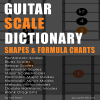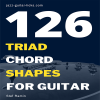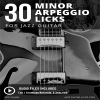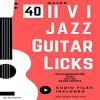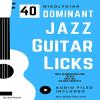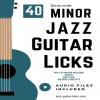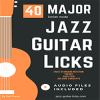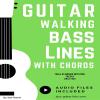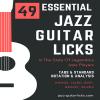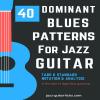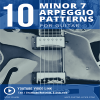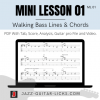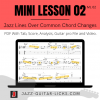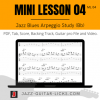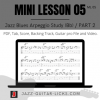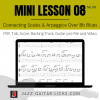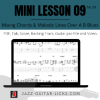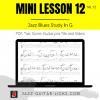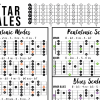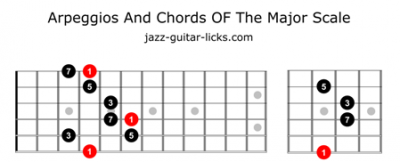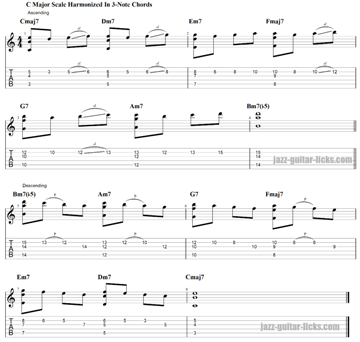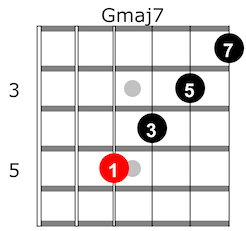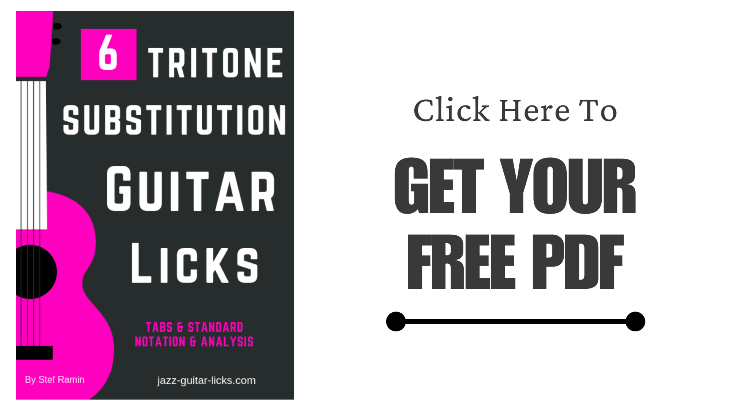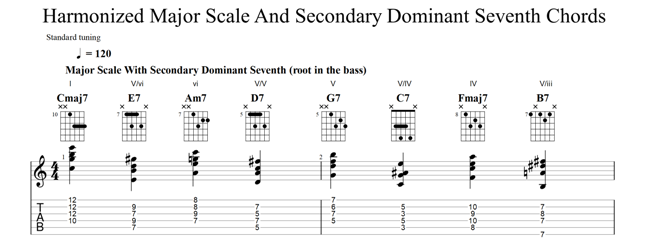
Major Scale And Secondary Dominant Seventh Chords - Free PDF Transcription And YouTube Short Videos
- By jazz-guitar-licks
- On 2023-08-17
- 2 comments
This guitar lesson implies playing secondary dominant seventh chords of the harmonized major scale.
Free PDF available on GUMROAD and four YouTube short videos at the bottom of this page.
How To Harmonize The Major Scale
Before tackling the four guitar exercises below, you need to know how to harmonize the major scale in seventh chords.
Harmonizing the major scale into seventh chords involves creating a chord for each degree of the scale using stacked thirds.
In a major scale, you'll have seven different degrees, and you can build a seventh chord on top of each one.
The quality of the seventh chord (major, minor, dominant, etc.) will depend on the notes within each chord and their relationship to the root of the chord.
Here's a breakdown of how to harmonize the major scale in seventh chords:
Build Seventh Chords:
Let's use the C major scale as an example: C D E F G A B C. On each degree of the scale, you'll build a seventh chord by stacking thirds on top of the root note.
- Degree I: Cmaj7 (C E G B)
- Degree II: Dm7 (D F A C)
- Degree III: Em7 (E G B D)
- Degree IV: Fmaj7 (F A C E)
- Degree V: G7 (G B D F)
- Degree VI: Am7 (A C E G)
- Degree VII: Bm7b5 (B D F A)
Chord Qualities:
- I (Cmaj7): Major 7th chord
- II (Dm7): Minor 7th chord
- III (Em7): Minor 7th chord
- IV (Fmaj7): Major 7th chord
- V (G7): Dominant 7th chord
- VI (Am7): Minor 7th chord
- VII (Bm7b5): Half-diminished (minor 7th flat five) chord
Roman Numeral Analysis:
You can also represent the harmonized chords using Roman numerals, where uppercase represents major and lowercase represents minor chords.
- I: Cmaj7
- ii: Dm7
- iii: Em7
- iv: Fmaj7
- V: G7
- vi: Am7
- vii: Bm7b5
Applications:
Understanding the harmonization of the major scale into seventh chords is essential for chord progressions, songwriting, and improvisation.
You can use these chords to create interesting chord progressions, modulations, and more.
Remember that the harmonization above follows the diatonic chords of the major scale.
Depending on the style of music you're working with, you might encounter variations or extended chords, but this basic harmonization is a solid starting point.
Basic Chord Voicings
Here are some basic chords showing how to harmonize the major scale on guitar.

Secondary Dominant Chords
Secondary dominant chords, also known as "V of V" chords, are chords that function as temporary dominants to a non-tonic chord within a key.
They are used to create a sense of tension and anticipation, leading to a chord that is not the tonic (I) chord.
Secondary dominants are a common technique in harmony and can add complexity and interest to chord progressions.
The concept of a secondary dominant is based on the fact that the dominant (V) chord has a strong tendency to resolve to the tonic (I) chord.
By temporarily introducing a dominant chord before a chord other than the tonic, you create a stronger pull toward that non-tonic chord.
Here's how secondary dominant chords work:
Basic Idea:
A secondary dominant is a dominant chord (V) that is borrowed from another key and used to lead to a chord other than the tonic (I) chord in the current key.
Notation:
A secondary dominant is usually notated as V/X, where X represents the chord that the secondary dominant is leading to.
Example in C Major:
- In the key of C major, the V chord is G7 (G B D F).
- To create a secondary dominant leading to the IV chord (F), you would use the V of IV, which is C7 (C E G Bb).
- The C7 chord has a strong pull to the F chord (IV), creating tension and resolution.
Common Secondary Dominants:
- V/V (the secondary dominant of the dominant) is a very common secondary dominant.
- V/ii (the secondary dominant of the supertonic) is another frequently used example.
- Other secondary dominants can be created for any diatonic chord by using the V chord of that chord's root.
Application:
Secondary dominants are often used to add harmonic interest and movement to chord progressions.
They can be found in various styles of music, including classical, jazz, and popular music.
Using secondary dominant chords can give your chord progressions a more colorful and dynamic sound by introducing unexpected harmonic shifts and resolutions.
Major Scale Harmonized With Secondary Dominant Seventh Chords
Here are four exercises implying the secondary dominant sevenths of each chord of the descending C major scale.
Notice that the vii chord (Bm7b5) has been voluntarily excluded, giving the following chord progression for the four exercices :
Cmaj7 | E7 | Am7 | D7 | G7 | C7 | Fmaj7 | B7 | Em7 | A7 | Dm7 | G7 | Cmaj7
Several chord voicings are used :
- Exercise 1 : Secondary dominant seventh chords with the root in the bass.
- Exercise 2 : Secondary dominant seventh chords with the 3rd in the bass.
- Exercise 3 : Secondary dominant seventh chords with the 5th in the bass.
- Exercise 4 : Secondary dominant seventh chords with the 7th in the bass.
Major Scale And Secondary Dominant Seventh Chords (1 of 4) - FREE PDF #guitarchords #guitarlesson
Major Scale And Secondary Dominant Seventh Chords (2 of 4) - FREE PDF #guitarlesson #guitarchords
Major Scale And Secondary Dominant Seventh Chords (3 of 4) - FREE PDF #guitarlesson #jazzguitar
Major Scale And Secondary Dominant Seventh Chords (4 of 4) - FREE PDF
-
Guitar Scale Dictionary
This E-book is a printable PDF method including over 700 scale diagrams and formula charts for guitarists. -
Guitar Chord Dictionary
This PDF eBook provides over 550 guitar chord shapes. This is the perfect reference guide to understand how chords are built and how to play them on the guitar neck. -
172 Arpeggio Shapes For Guitar
This printable PDF is a method dedicated to guitarists of all styles who want to learn build and play the most important types of arpeggios. -
126 Triad Chord Shapes
This handbook for guitar players is intended both for teachers and students. It includes 126 guitar shapes for mastering triads. -
Harmonic Major Scale Chords
this PDF offers diagrams and tabs for guitar to learn the chords of the harmonic major scale. -
Major Scale Harmonization
This package provides a printable PDF with exercises and audio files to learn how to harmonize the major scale with 3 note chords and their extensions. -
30 Minor Arpeggio Licks
This package includes a printable PDF method containing 30 exercises with tabs, staves and audio files for practicing minor arpeggios on guitar. -
II V I Bundle - 170 Exercises
This bundle contains 4 PDF methods for a total of 170 exercises with tabs, staves, analysis & audio files for practicing scales, arpeggios licks & chords over the 2-5-1 progression. -
Diatonic Licks Bundle
This package contains 120 jazz guitar lines based on diatonic modes as Mixolydian, Dorian and Ionian. PDF format with tabs, audio files and analysis. -
30 Groovy Jazz Guitar Licks
This downloadable package contains a PDF WITH audio files giving access to 30 groovy guitar phrases mixing jazz, blues and funky licks for beginners. -
30 Smooth Jazz Guitar Licks
In this package you'll get a printable PDF Method with tabs, notation, analysis, scale shapes and audio files for practicing 30 smooth jazz guitar licks. -
40 II V I Jazz Guitar Licks
This pdf method for guitar contains fourteen 2 5 1 jazz guitar lines with tab, standard notation, analysis, scale charts and audio files. -
50 II-V-I voicings
This printable PDF guitar method provides 50 exercises with audio files, analysis, tab and staves for learning major 2-5-1 chord voicings. -
40 Minor 2 5 1 Chord Voicings
This PDF method contains 40 exercices with tabs, scores and audio files for practicing jazz guitar chords over the minor 2 5 1 progression. -
40 Minor II V I Licks
This guitar method is a printable PDF with tabs, diagrams, theory and audio files providing 40 minor 2 5 1 jazz patterns. -
40 Mixolydian Jazz Guitar Lick
PDF guitar method with tabs, audio files and theory providing 40 dominant jazz guitar lines for teachers and students. -
40 Minor Jazz Guitar Licks
This printable guitar method in PDF format contains 40 easy minor jazz guitar lines based on the Dorian mode. -
40 Major Jazz Guitar Licks
Printable PDF eBook method containing 40 major jazz guitar licks with tab, standard notation and audio files for beginners and intermediates. -
Guitar Walking Bass Lines
This jazz guitar method about walking bass lines and chords is available as a PDF files containing 35 exercises with tabs, analysis and audio files -
101 Dominant Arpeggio Patterns
This printable PDF method provides 101 dominant arpeggio exercises with tab, theory and standard notation for the jazz, blues and rock guitarist. -
49 Essential Jazz Lines
This printable eBook method in PDF format provides 49 jazz solo transcriptions of the greatest jazz musicians. Tab, standard notation, audio files & analysis. -
11 Jazz Blues Studies
11 jazz blues chord studies with tabs, standard notation, analysis, and audio recordings and PDF. -
10 Easy Fingerstyle Blues
This PDF with Tabs and audio files provides 10 easy acoustic fingerstyle blues guitar studies for kids and beginners. -
25 Altered Jazz Guitar Lines
This PDF eBook method contains 25 altered jazz guitar licks with tabs, patterns, scale charts and audio files to master, apply and develop the altered scale. -
40 Blues Dominant Patterns
This printable method is available as a PDF file containing 40 easy dominant jazz-blues guitar lines with tabs, standard notation, analysis, audio files and scale charts. -
25 Pentatonic Licks
This jazz guitar method is an eBook available as a PDF with standard notation, guitar tabs, diagrams, analysis, audio files and backing tracks. You will find in this booklet 25 easy jazz guitar lines with theory using common and rare pentatonic scales. -
25 Soul Jazz Guitar Licks
You will find here an eBook available in PDF containing 25 soul jazz and hard bop guitar licks in the style of Grant Green, Melvin Sparks, George Benson. -
25 Diminished Patterns
This eBook PDF with audio files contains 25 dominant diminished jazz guitar patterns using the half-whole diminished scale and diminished 7th arpeggios. -
6 Tritone substitution licks
This Printable PDF eBook available for free download contains 6 easy jazz guitar licks with tabs/notation, youtube video link and analysis about the tritone substitution. -
10 Minor 7 Arpeggio Patterns
This printable PDF eBook offers 10 easy minor 7 arpeggio patterns with its related YouTube video for beginner guitarists. -
10 Easy Major 7 Arpeggio Licks
This is a printable PDF for beginner jazz guitar players providing 10 easy licks to practice major 7 arpeggios. -
10 Chord Melody Lines
Within this package, you'll discover a set of ten chord melody exercises for beginners. Printable PDFaudio files, a backing track, and a link to the associated YouTube video. -
10 Minor Blues Scale Licks
You'll find here a PDF with 10 easy jazz guitar licks to practice the minor blues scale on guitar.
-
Mini Lesson 01 (ML 01)
You'll find a mini guitar lesson about walking bass lines and chords containing a PDF with tab, score analysis, shapes, a video and a guitar pro file. -
Mini Lesson 02 (ML 02)
In this mini jazz guitar lesson you will learn how to play easy and cool jazz lines over basic chord changes found in jazz. Pdf, tab and video included. -
Mini Lesson 03 (ML 03)
With this short lesson you will learn how to play and connect basic guitar arpeggios over a diatonic chord progression. -
Mini Lesson 04 (ML 04)
This is a downloadable package with PDF, Tab, guitar pro file and video to practice guitar arpeggios over a jazz blues chord progression. -
Mini Lesson 05 (ML 05)
This downloadable package provides a PDF with Tab/score, a guitar pro file and a short video for practicing guitar arpeggios on a jazz blues progression in Bb. -
Mini Lesson 06 (ML 06)
This package for guitarists contains a PDF with tab, video, backing track and guitar pro file for practicing arpeggios over a basic jazz blues progression. -
Mini Lesson 07 (ML 07)
With this mini guitar lesson you will learn how to superimpose arpeggios over a diatonic chord progression. Video, pdf, jamtrack and guitar pro file included. -
Mini Lesson 08 (ML08)
Mini lesson with PDF, guitar pro file, video and backing track for practicing scale and arpeggio connections over a Bb jazz blues progression. -
Mini Lesson 09 (ML09)
This mini lesson is a downloadable package containing a PDF, video, backing track and guitar pro file of a jazz blues progression study in B. -
Mini Lesson 10 (ML 10)
This mini guitar lesson provides a printable PDF with tab/notation, video, backing track and guitar pro file for practicing open triads over Fly Me To The Moon. -
Mini Lesson 11 (ML 11)
This guitar lesson is a package inlcuding a PDF transcription with analysis, a short video, a backing track and a guitar pro file to learn to play jazz solo lines over Blue Bossa. -
Jazz Blues Guitar Study (ML12)
This mini lesson provides a video, a guitar pro file and PDF transcription of a jazz blues study in G implying melodic lines, chord extensions and substitutions
-
Downloadable and printable music cheat sheets for guitar teachers and students.
-
Educational and decorative guitar posters and wall art for students and instructors. Scales, chords, licks, arpeggios, triads and music theory.
chords harmonization major scale dominant seventh guitar chords
Comments
-

- 1. Holly B On 2024-12-26
Awesome thanks a lot. I will try to apply this to my favorite chord progressions.-
- jazz-guitar-licksOn 2024-12-26
yes glad you like it. Stef
Add a comment

